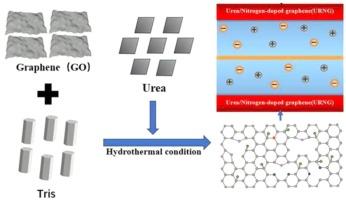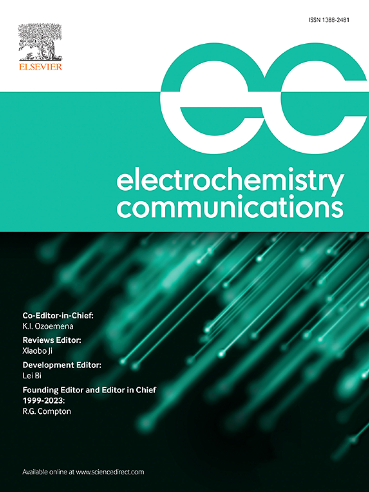尿素- tris掺杂3D石墨烯用于高稳定性超级电容器
IF 4.2
3区 工程技术
Q2 ELECTROCHEMISTRY
引用次数: 0
摘要
超级电容器的商业化关键取决于开发能够同时提供高能量密度和长期稳定性的低成本电极材料。为了解决这一挑战,我们开发了一种双氮掺杂策略,使用三甲基氨基甲烷(tris)和尿素通过一步水热工艺制备三维氮掺杂石墨烯(URNG)。对材料的表征表明,优化后的URNG的氮构象与单一氮源掺杂石墨烯(NG)相比,吡咯- n含量增加了2.07%,这一变化在保持结构完整性的同时显著提高了电荷存储能力。电化学测量表明,在670 W·kg - 1的功率密度下,组装的对称超级电容器获得了57.2 Wh·kg - 1的高能量密度。URNG电极在0.5 a·g−1时的比电容为194.2 F·g−1(比NG高17.1%),在5000次循环后保持87%的电容保持率。通过为1.8 V LED器件供电,成功证明了该材料的实用性。这项工作不仅提供了一个简单的合成策略,而且为先进的储能系统提供了氮配置控制的基本见解。本文章由计算机程序翻译,如有差异,请以英文原文为准。

Urea-Tris doped 3D graphene for high-stability supercapacitors
The commercialization of supercapacitors hinges critically on developing low-cost electrode materials capable of simultaneously delivering high energy density and long-term stability. To address this challenge, we developed a dual‑nitrogen doping strategy using tris(hydroxymethyl)aminomethane (Tris) and urea to fabricate three-dimensional nitrogen-doped graphene (URNG) through a one-step hydrothermal process. Characterization of the material reveals that the optimized nitrogen conformation of URNG has a 2.07 % increase in pyrrole-N content compared to single nitrogen-source doped graphene (NG), a change that significantly enhances the charge storage capacity while maintaining structural integrity. Electrochemical measurements demonstrate that the assembled symmetric supercapacitor achieves a high energy density of 57.2 Wh·kg−1 at a power density of 670 W·kg−1. The URNG electrodes deliver a specific capacitance of 194.2 F·g−1 at 0.5 A·g−1 (17.1 % higher than NG) while maintaining 87 % capacitance retention after 5000 cycles. The practical applicability of this material was successfully demonstrated by powering a 1.8 V LED device. This work not only provides a facile synthesis strategy but also offers fundamental insights into nitrogen configuration control for advanced energy storage systems.
求助全文
通过发布文献求助,成功后即可免费获取论文全文。
去求助
来源期刊

Electrochemistry Communications
工程技术-电化学
CiteScore
8.50
自引率
3.70%
发文量
160
审稿时长
1.2 months
期刊介绍:
Electrochemistry Communications is an open access journal providing fast dissemination of short communications, full communications and mini reviews covering the whole field of electrochemistry which merit urgent publication. Short communications are limited to a maximum of 20,000 characters (including spaces) while full communications and mini reviews are limited to 25,000 characters (including spaces). Supplementary information is permitted for full communications and mini reviews but not for short communications. We aim to be the fastest journal in electrochemistry for these types of papers.
 求助内容:
求助内容: 应助结果提醒方式:
应助结果提醒方式:


